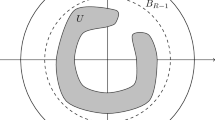Summary
Unlike its predecessor this second paper formulates the problem of seashell geometry entirely in real spaceE 3, presenting those equations of most use for parctical digital computer similations. The mathematics dilates previously mentioned clockspring “wires” (growth trajectoriesY(ϕ)) into tubular spiral surfacesr(σ, ϕ) complete with orthoclinal growth lines and simple periodic corrugations or flaresQ(σ, ϕ). It is seen that second-order theory requires a new boundary condition, the famous HLOR growth vectorr(σ, 0), which is absent from classical analyses. Thus it is demonstrated that simple periodic surface features, of a kind occurring widely in nature, obey precise Cauchy boundary conditions which may be related to the quantized cyclicities of metabolic, and geophysical, rhythms associated with biological shell growth.
Riassunto
A differenza del precedente quest'articolo formula il problema della geometria delle conchiglie completamente in spazio realeE 3, quindi presentando quelle equazioni piú utili nella simulazione pratica del computer numerico. In questa discussione i “fili” elastici a molla d'orologio (traiettorie di crescitaY(ϕ)) sono dilatari quindi diventano superfici a spirale tubolarer(σ, ϕ) e completi di anelli ortoclinati (orientati perpendicolari alla direzione di crescita) e onduleQ(σ, ϕ) periodiche semplici. Si vede che nella teoria di secondo ordine è richiesta una condizione di confine nuova, il ben conosciuto HLOR vettore di crescitar(σ, ϕ), che è assente nell'analisi classica. Quindi è dimostrato che le caratteristiche periodiche semplici delle superfici, simili a quelle molto frequenti in natura, obbediscono a precise condizioni di confine di Cauchy le quali possono essere collegate con ciclicità pulsanti di ritmi metabolici e geofisici associati con la crescita biologica delle conchiglie.
Резюме
В отличие от первой части в этатье формулируется проблема геометрии морской раковины полностью в реальном пространствеE 3, с целью получения уравнений, удобных для практического компьютерного моделирования. Математический аппарат позволяет растянуть ранее предложенные растущие траекторииT(ϕ) в цилиндрические поверхностиr(σ, ϕ), которые заканчиваются ортоклинными растущими линиями и простыми периодическими складками или раструбамиQ(σ, ϕ). Отмечается, что теория второго порядка требует нового граничного условия, известного HLOR вектораr(σ, 0), который отсутствует в классическом анализе. Показывается, что характеристики простых периодических поверхностей, широко встречающихся в природе, подчиняются граничным условиям Коши, котрые могут быть связаны с квантованными цикличностями метаболических и геофизических ритмов, связанныу с ростом биологических раковин.
Similar content being viewed by others
References
C. R. Illert:Math. Biosci.,63, 21 (1983).
SirD. W. Thompson:On Growth & Form (C.U.P., Cambridge, 1917).b) Crescita e forma (Boringhieri, Torino, 1969).
P. J. Davis:The Schwarz Function and its Applications, Carius Monograph 17, Mathematical Association of America (1974).
C. R. Illert:Nuovo Cimento D,9, 791 (1987).
H. Meinhardt andM. Klinger:J. Theor. Biol.,126, 63 (1987).
a)|G. Owen:Q. J. Microsc. Sci.,94, 57 (1953)b K. M. Wilbur andC. M. Yonge:Physiology of Mollusca, part 1 (Academic Press, New York, N. Y., 1964), p. 218.
M. J. S. Rudwick:Geol. Mag.,96, 1 (1959).b)L. Lison:Mem. Inst. R. Nat. Sci. Belg.,34, 1 (1949).c)G. J. Vermeij:Forma Functio,4, 319 (1971).
W. F. Bronsvoort andF. Flok:ACM Trans. Graphics,4, 291 (1985).
R. M. Linsley:Paleobiology,3, 196 (1977).b) Am. Sci.,66, 432 (1978).c) Lethaia,14, 224 (1981). See also (10).
C. G. Mcnair et al.:Lethaia,14, 63 (1981).
G. J. Vermeij:Lethaia,14, 104 (1981).
C. R. Illert:Bull. Math. Biol.,50, 19 (1988).
O. Snell:Arch Psychiat. Nervkrankh.,23, 436 (1891).b)P. F. Verhulst:Correspondene mathématique etc., publié par M. A. Quetelet, Vol.10 (1838), p. 113.
C. R. Stasek:J. Morphol.,112, 195 (1963).
C. Illert:Of Sea & Shore,12, 8 (1981).
G. E. McGinitie andN. McGinitie:The Natural History of Marine Animals (McGraw Hill, New York. N. Y., 1949). See p. 327–401 and in particular p. 353–356.
R. M. Linsley:Malacologia,20, 153 (1980).
C. Illert:Of Sea & Shore,11, 141 (1980).
E. Savazzi:Lethaia,20, 293 (1987).
Author information
Authors and Affiliations
Rights and permissions
About this article
Cite this article
Illert, C. Formulation and solution of the classical seashell problem. Il Nuovo Cimento D 11, 761–780 (1989). https://doi.org/10.1007/BF02451562
Received:
Issue Date:
DOI: https://doi.org/10.1007/BF02451562




